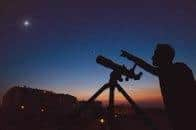Three East Sussex towns named as the some of the ultimate stargazing spots in the UK
and live on Freeview channel 276
Global Astronomy Month (April 2023) and International Dark Sky Week (April 15 to 22), searches for “where to see stars” have soared in the UK by 9469 per cent between the 28th and 29th of March.
BestGamblingSites.com analysed light pollution data to predict the best and worst locations in the UK for stargazing this April, with three towns in East Sussex named as some of the best places in the country.
Advertisement
Hide AdAdvertisement
Hide AdUckfield came second in the list with a star visibility score of 73.8/100. Uckfield has a Sky Quality Meter reading of 20.84 (mag./arc sec2), which is just 1.16 points away from being the darkest score possible, certifying that the area has very minimal light pollution and is extremely dark — making it a perfect location to view stars. Not only this, but Uckfield has a Borte Scale classification, a the scale runs from one (darkest, best for stargazing) to nine (worst for stargazing) of four, just one point higher than St Davids in Wales which came in first, further highlighting the darkness of the sky above the town.


Eastbourne came joint eighth with a visibility score of 70.8 and Hastings ranked 15th with a visibility score of 68.6.
BestGamblingSites.com can predict that the UK location estimated to have the clearest view of stars this Dark Sky Week is St Davids in Pembrokeshire, Wales, with a star visibility score of 74.4/100. St Davids, Britain’s smallest city, has a Borte Scale classification of 3. , St Davids has the lowest level of light pollution of all 82 cities analysed, making it the ultimate dark sky location to view stars. In comparison, Cardiff, Glamorgan, has a classification of 7, just two points away from having the worst possible grade for stargazing.
Ranking third is Truro in Cornwall, England, with a star visibility score of 73.5/100. Truro has an artificial brightness score of just 335 μcd/m2, guaranteeing a low light intensity and dark sky. Truro is the only area in Cornwall to make the list and has a Sky Quality Meter reading of 20.82 (mag./arc sec2),10% darker than the reading in nearby Plymouth, Devon (18.74 mag./arc sec2). In comparison, Plymouth’s score is just 2.74 points from having the brightest reading possible (16).
Advertisement
Hide AdAdvertisement
Hide AdJames Roy, brain health expert from Brainworks Neurotherapy, said on the impact of light pollution and not seeing stars regularly: “As humans, we are biologically inclined to be awake during the day and asleep at night. Daylight is the natural regulator of our circadian rhythms, so the more light we introduce into our nighttime skies, the harder it is for our bodies to determine what time it actually is.
“Even low levels of artificial light intensity at night have been found to suppress melatonin production, our sleep hormone which induces drowsiness, making it harder for us to fall asleep. This can lead to insomnia which will cause tiredness, fatigue and poor mental health.
“On a brain level, the 'out of sync' daylight hours and sleep disruption weaken the power of our all-important frontal lobes. A weakening of our frontal brain activity impairs memory, decision making and our ability to regulate our emotional reactions.”